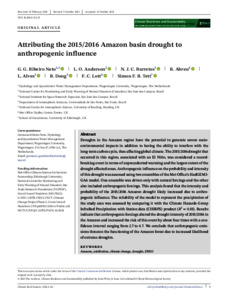Attributing the 2015/2016 Amazon basin drought to anthropogenic influence
Ribeiro Neto, G. G., Anderson, L. O., Barretos, N. J. C., Abreu, R., Alves, L., Dong, B.
It is advisable to refer to the publisher's version if you intend to cite from this work. See Guidance on citing. To link to this item DOI: 10.1002/cli2.25 Abstract/SummaryDroughts in the Amazon region have the potential to generate severe socio-environmental impacts in addition to having the ability to interfere with the long-term carbon cycle, thus affecting global climate. The 2015/2016 drought that occurred in this region, associated with an El Niño, was considered a record-breaking event in terms of unprecedented warming and the largest extent of the drought affected areas. Anthropogenic influence on the probability and intensity of this drought was assessed using two ensembles of the Met Office's HadGEM3-GA6 model. One ensemble was driven only with natural forcings and the other also included anthropogenic forcings. This analysis found that the intensity and probability of the 2015/2016 Amazon drought likely increased due to anthropogenic influence. The reliability of the model to represent the precipitation of the study area was assessed by comparing it with the Climate Hazards Group InfraRed Precipitation with Station data (CHIRPS) product (R2 = 0.81). Results indicate that anthropogenic forcings altered the drought intensity of 2015/2016 in the Amazon and increased the risk of this event by about four times with a confidence interval ranging from 2.7 to 4.7. We conclude that anthropogenic emissions threaten the functioning of the Amazon forest due to increased likelihood of extreme droughts.
Download Statistics DownloadsDownloads per month over past year Altmetric Deposit Details University Staff: Request a correction | Centaur Editors: Update this record |
 Tools
Tools Tools
Tools
![Open Access [thumbnail of Open Access]](https://centaur.reading.ac.uk/101113/1.hassmallThumbnailVersion/Neto_etal_Amazon_drought_2021.pdf)
